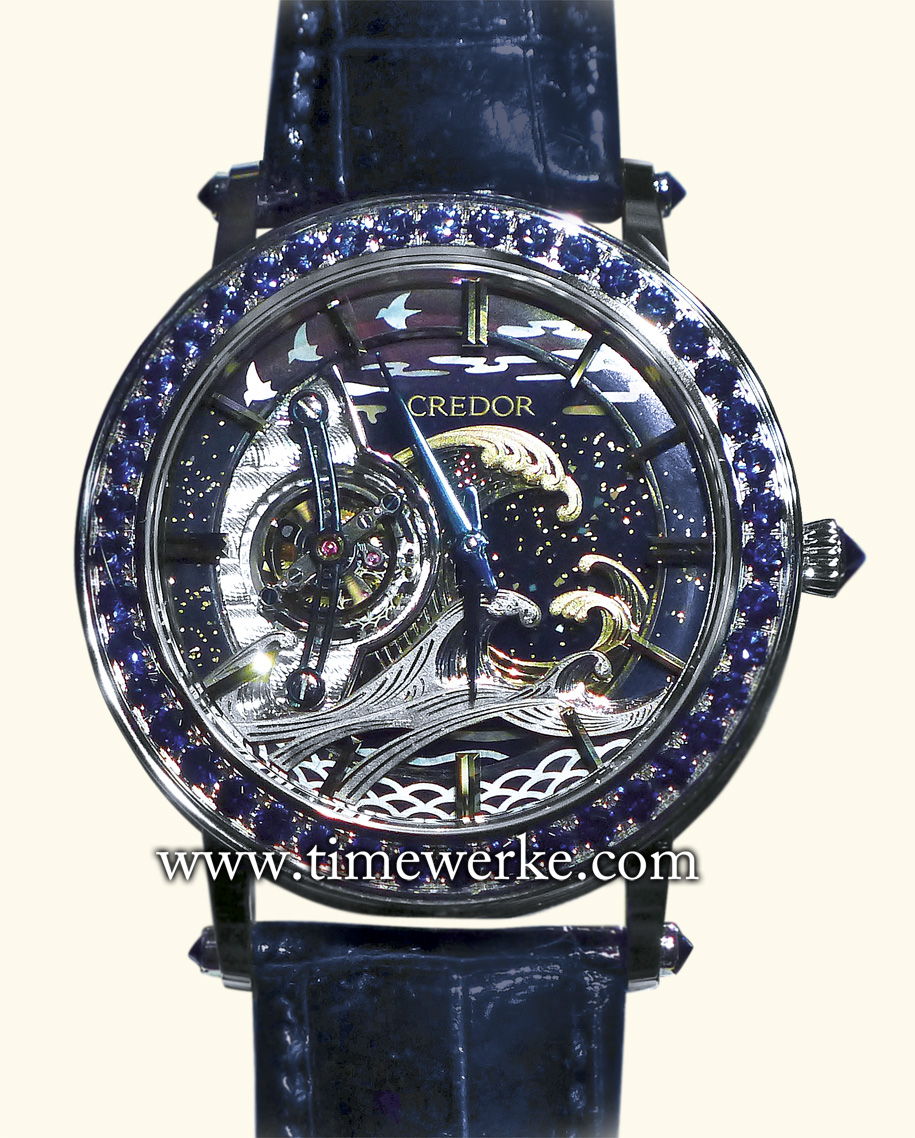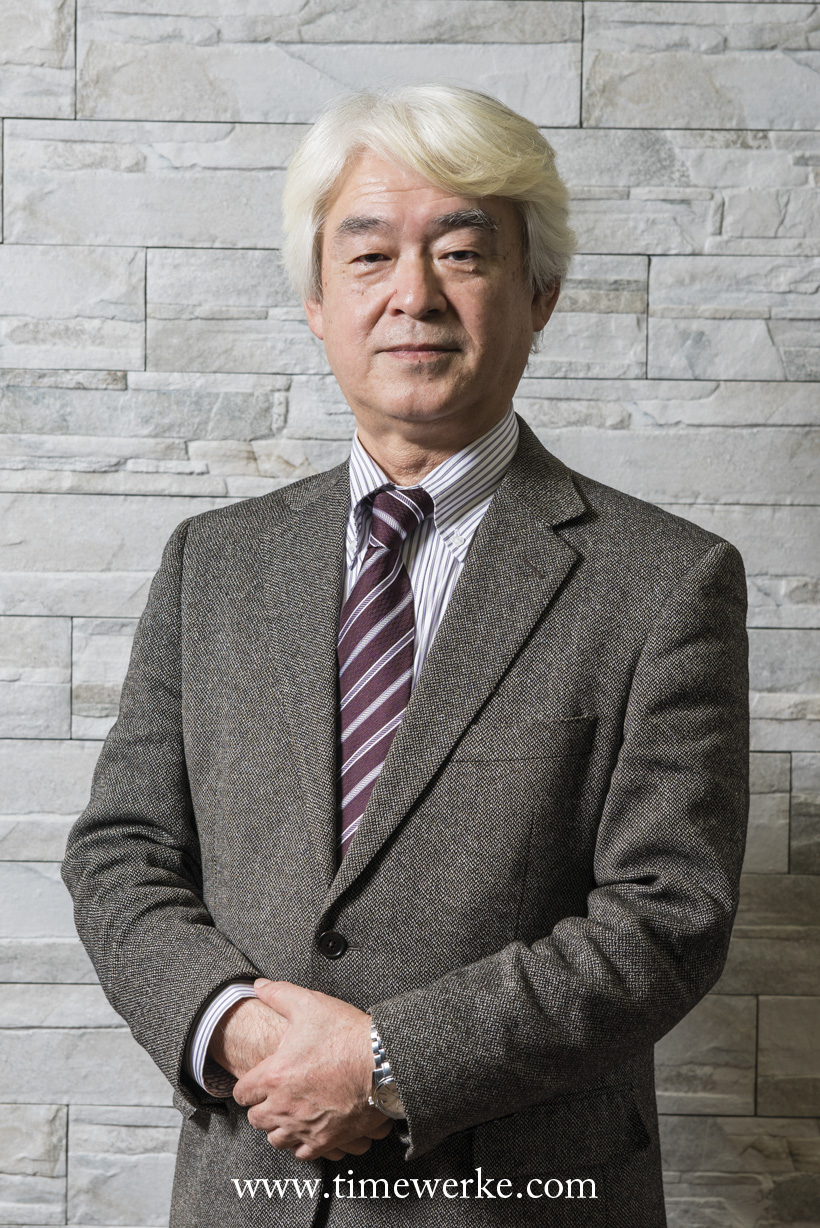
Seiko’s very first tourbillon – The Credor Fugaku Tourbillon Limited Edition,
GBCC999. Introduced at the 2016 BaselWorld watch fair and limited to 8 pieces.
It features the Calibre 6830 manual-winding movement beating at the frequency of 21,600 vibrations per hour (6 beats per second) and has approximately 37 hours power reserve when fully wound.
The base plate is 1.98mm thick and the movement’s height is 3.98mm with a diameter of 25.6mm. This effectively means that this is the world’s smallest tourbillon by volume as at January 2016, according to Seiko.
In terms of accuracy, the mean daily rate is between -10 / +15 seconds. The dial in either 18K white gold or 18K yellow gold with engraving, Urushi lacquer, mother-of-pearl, Yakogai (turban shell)
The case is available in either platinum 950, 18K white gold or 18K yellow gold and is set with 48 blue sapphires (3.22 carats including those on the crown and lugs).
The case is 43.1mm in diameter case and is 8.8mm thick.
Priced at 50 million Japanese Yen inclusive of tax.
Photo: © TANG Portfolio. Elfa / Timmy. BaselWorld 2016. Photo taken at BaselWorld 2016 and with a Leica D-Lux 5.
It may come as a surprise for some to know that Seiko’s very first tourbillon was only launched in 2016 at the BaselWorld watch fair. This may be so especially for those who know that the brand’s roots can be traced back to the late 19th century.
The brand’s origins began in 1881, initially offering simple clock repair services in addition to the retail of clocks. In 1892, it had a factory named Seikosha producing wall clocks.
In 1895, Seikosha produced the first Japanese-made pocket watch under the “Time Keeper” brand name. By 1910, Seikosha could already make its own balance springs.
While Seikosha’s first in-house produced wristwatch was completed in 1913, it was branded “Laurel”. It was only in 1924 that the facility made a watch that was branded “Seiko”. The rest, as they say, is history.
Credor, a sister brand, is where one will discover high-end timepieces. With Seiko’s deep involvement in watchmaking and its rich legacy, very refined watches that have emerged from its own in-house development include the Credor Spring Drive Minute Repeater and the Credor Spring Drive Sonnerie.
Far from jumping onto the bandwagon when tourbillons were all the rage in the early 21st century, Seiko focused first on what is deemed the highest complication – the Grande Sonnerie which made its debut in 2006 and named the Credor Spring Drive Sonnerie.
What followed was the Credor Spring Drive Minute Repeater in 2011. This is a rather unusual step as most watchmaking companies would create their own minute repeater first before attempting the Grande Sonnerie.
In 2016, Seiko launched its Credor Fugaku Tourbillon. Similarly, this is seen as an unusual step as most high-end watchmaking companies or brands would initially focus their in-house resources on tourbillons before entering into the development of more complicated mechanisms like striking mechanisms such as repeaters and Grande Sonneries.
The artistry behind Credor’s Fugaku Tourbillon is inspired by the famed Under the Wave Off Kanagawa (Kanagawa oki nami ura) – also known as The Great Wave.
This is a beautiful artwork by Japanese artist Katsushika Hokusai (1760 to 1849) created during the Edo period (circa 1830 to 1832) from his series, Thirty Six Views of Mount Fuji (Fugaku sanjūrokkei).
The Great Wave features a massive wave about to come crashing down on fishing boats and in the background, one can catch a glimpse of Mount Fuji, Japan’s highest mountain standing at 3,776 metres tall.
Christening this high watchmaking creation the “Fukagu” is apt because Fugaku sanjūrokkei is another name for Mount Fuji.
The detailed engraving works were performed by Kiyoshi Terui, a metal engraver who is based at the Shizuku-ishi Watch Studio.
The lacquer works were created with the hands of artist Isshu Tamura. He was also responsible for the Credor branding on the dial which is handcrafted in gold lacquer or maki-e.
The tourbillon movement – the manual-winding Calibre 6830 used in the Credor Fugaku Tourbillon is based on the ultra-thin Calibre 68 family. The Calibre 6830 tourbillon movement was made and assembled by Satoshi Hiraga who is based at the Shizuku-ishi Watch Studio.
The Calibre 6830 is Seiko’s very first tourbillon movement. The base plate is 1.98mm thick and the movement’s height is 3.98mm with a diameter of 25.6mm.
This means that this is the world’s smallest tourbillon by volume as at January 2016, according to Seiko.
Volume reduction came about through the use of a unique pallet fork design and by integration of the wheel and bridge, Seiko discloses. There was also weight reduction thanks to the use of titanium in some parts of the carriage.
Noboru Kosugi was responsible for the overall design, the integration of the tourbillon, metal engraving and lacquer work. This gentleman was the first watch designer to become a Master Craftsman.

Noboru Kosugi, Designer, Seiko Instruments Inc., Design Division. In 2014, he was the first watch designer recognized as a Contemporary Master Craftsman by the Japanese government. In April 2016, Kosugi was awarded the Medal with Yellow Ribbon by the Japanese government. Kosugi was responsible for the overall design of the Credor Fugaku Tourbillon and was in charge of design of the Grand Seiko Hi-Beat SBGJ005 which secured the Petite Aguille prize at the 2014 Grand Prix d’Horlogerie de Genève. Photo: © Seiko
In April 2016, Kosugi was awarded the “Medal with Yellow Ribbon” from the Japanese government. Such an award is conferred bi-annually, on 29 April in spring and 3 November in autumn.
According to the Japanese Cabinet office, the Medal with Yellow Ribbon is awarded to individuals who, “through their diligence and perserverance, become public role models”.
There were three “Contemporary Master Craftsman” in addition to lacquer artist Isshu Tamura behind the Credor Fugaku Tourbillon.
The trio being Kiyoshi Terui, Satoshi Hiraga and Nobuhiro Kosugi. By understanding the key inspiration for the Credor Fugaku Tourbillon – The Great Wave Off Kanagawa, the artistry behind it and the technical nature of the watch mechanism, one can have a much fuller appreciation of this tourbillon.
Seiko’s very first tourbillon may have come much later than many high-end Swiss watch brands but it has been presented with much panache and has a deep and long-lasting impression.
Seiko states that this Credor Fugaku Tourbillon is: “A work of art that expresses the essence of Japanese beauty.” We fully agree.
Moreover, it is our opinion that Seiko’s first tourbillon is simply watchmaking par excellence and deserves the honour of being one of the top watches presented at the BaselWorld 2016 watch fair.
We wholeheartedly congratulate Kosugi for being the first watch designer to be recognised as a Master Craftsman and his Medal with Yellow Ribbon award.
We fully appreciate Katsushika Hokusai’s Under the Great Wave Off Kanagawa and this explains why we truly enjoy and fully respect the artistry behind Credor’s Fugaku Tourbillon.
We also congratulate Seiko for debuting their very first tourbillon which is presented as a meaningful and symbolic timepiece.
Why is it symbolic? Consider the era during which Katsushika Hokusai’s The Great Wave was created. This was between 1830 and 1832.
As highlighted in an article found on Khan Academy (written by Leila Anne Harris) on The Great Wave, this print was created at a time when Japanese trade was heavily restricted.
However, prints of The Great Wave subsequently became a source of inspiration for many European artists in the 19th century, among whom were Debussy for La Mer (The Sea) and Rilke’s Der Berg (The Mountain).
Hokusai’s Under the Wave Off Kanagawa even inspired the design of a 20th century brand – Quicksilver. Founded in 1969, Quicksilver is an Australian brand.
We are confident a similar pattern will emerge for Credor which is currently more well-known in Japan due to its limited distribution worldwide. As more discerning watch collectors outside of Japan understand the high technical and artistic craftsmanship involved in its timepieces, more will be inspired to better appreciate Credor.
